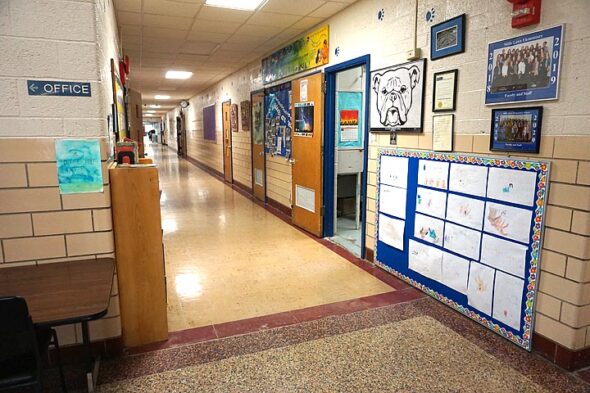
(Photo by Carol Simmons)
Yellow Springs Schools— District faces funding cuts, uncertainty
- Published: June 11, 2020
A $300 million cut in funding to Ohio schools this fiscal year, announced by Gov. Mike DeWine in May, will mean the loss of more than $140,000 in anticipated revenue for Yellow Springs Schools over May and June, according to state and district administrators.
The temporary decrease in education funding is part of $775 million in total state budget cuts related to the economic consequences of the COVID-19 pandemic. In announcing the cuts, DeWine said the move was necessary to offset a projected $776.9 million decrease in state revenue, mostly in the form of income and sales taxes lost as a result of the emergency shutdown of most businesses.
With the uncertainty about how long the pandemic will continue and its further economic effects, DeWine suggested additional K–12 cuts could be announced later in the new fiscal year, which begins July 1. He said he believes that making the recently announced cuts now will lessen the financial blow of what would likely have been larger cuts down the road.
State funding makes up 15% of Yellow Springs’ $10 million budget, and the newly announced cuts amount to a 1.46% reduction in total revenue, district Treasurer Tammy Emrick reported to the school board during the board’s most recently scheduled regular meeting in May.
Any cuts hurt the bottom line, especially when the district is already spending more than it is taking in this year, Emrick told the board, but she feels a 1.46% decrease is workable.
“If we are cautious in our spending … we should be able to weather this pandemic,” Emrick said.
She also reported that “we’re in a better position than a lot of school districts” in terms of lost revenue.
Larger districts in Greene County, with proportionally larger budgets, appear especially hard hit, with Beavercreek taking a $2 million loss and Fairborn and Xenia each seeing cuts of more than $800,000, according to state data.
In looking at per-pupil amounts, however, Yellow Springs’ reduction of $261 per student is higher than any other district in the county. Beavercreek is close, at $259, while Fairborn has the lowest at $185, according to the state. The formula for making the cuts was based on a district’s relative wealth.
Despite the unexpected loss in revenue, district administrators “as of right now” are not planning any cuts or delays in currently budgeted expenditures, the treasurer wrote in an email in response to a News inquiry.
“We will continue to be very thoughtful about how and where we spend money,” she wrote.
In addition to informing the board about the new state cuts, Emrick presented the annual May update on the district’s five-year forecast, which is compiled each October. As previously projected by Emrick as well as the former district treasurer, and reported in the News, Yellow Springs Schools began deficit spending — when expenditures exceed revenues — in fiscal year 2019, when the district’s expenses surpassed income by nearly $470,000.
This year’s difference had been projected at about $412,000 before the new cuts were announced. Emrick reported that the financial forecast update was completed the week before the governor’s announcement and so does not reflect the district’s additional $140,115 in state cuts. The forecast, thus, shows state funding remaining flat at 15% for the next five years. Other financial effects of the pandemic, such as possibly reduced income tax revenues, are also not factored in because they are so uncertain, Emrick said.
Asked later by the News why the forecast report, which was completed a month before it was due to the Ohio Department of Education (ODE) May 31, was not revised to account for the known cuts, Emrick replied that the document had already been distributed internally, and “general fiscal uncertainty” led to the decision to point to the cuts in the document’s notes without adjusting the figures.
“Having a budget cut announced one week prior to the board meeting does not give enough time to make the changes and to disseminate to the board,” she wrote in an email. “We require items for board meetings one week prior so we don’t have to keep making changes to the board agenda.”
Even without the adjustments, the five-year forecast shows continued deficit spending each year, with the district’s cash reserves shrinking to less than $400,000, nearly $1 million less than the fiscal standard of having 30 days operating cash on hand, by 2024. The end-of-year cash reserves for fiscal year 2019 was about $5 million, and is projected at about $4.6 million for 2020.
Planning for the unknown
The district is facing a lot of uncertainty, not only financially, but also in what to expect for the coming year, district Superintendent Terri Holden told the board during the May meeting.
Board President Steve Conn spoke sympathetically about the difficulties of planning.
“The speed at which things are changing” is a challenge, he said. “There is just a series of complicated variables.”
Earlier this week, Gov. Mike DeWine announced that he intended to open Ohio’s K–12 schools in the fall, with local school boards determining their individual start dates.
Prior to the governor’s announcement, Holden had begun planning for three possible scenarios for the 2020–21 academic year: “going back to the way it used to be,” with students in the school buildings full time; “a blended approach” of part in-school, part remote learning; and an “all-virtual approach.”
She noted that any re-entry plan will need approval by Greene County Public Health.
Holden also said that the Ohio Department of Education’s 12-page draft re-entry and restart guide, which was released May 12, doesn’t offer much helpful guidance.
“It caused me some concern reading it,” she said, referring specifically to sections where the document states that the ODE will offer guidance, and then notes in parenthesis that “guidance is under development.” The ODE wrote in an introductory letter to the draft document that the guide is being revised and likely will be updated throughout the summer.
For now, the state is calling for districts to take a variety of precautionary health measures when schools reopen. According to the ODE, a safe return means:
• students’ temperatures taken before leaving home;
• face masks worn by all students and teachers;
• multiple hand sanitizing stations located throughout the schools, including at each entrance and in every classroom;
• desks placed at least six feet apart, among other distancing actions;
• no field trips;
• visitors limited or prohibited.
Holden said that preparation could cost the district tens of thousands of dollars.
She said she has given maintenance supervisor Craig Carter the responsibility of gathering supplies: “soap, hand sanitizer, masks, disinfectant cleaners with appropriate cleaning power, garbage cans with no open lids, hands-free paper towel dispensers, etc.”
In anticipation of the restart day — whenever it might be — the district has already ordered “a first batch” of masks — enough for every staff member and student, plus some extras, Holden said. The 1,000 washable masks, featuring the Yellow Springs Schools logo, cost $5,750, she wrote in an email in response to a News inquiry.
Holden is also considering proposing a later start date for the 2020–21 school year, and said she would bring her recommendation to the next regularly scheduled school board meeting in June. The local school board meets the second Thursday of each month, typically beginning at 7 p.m.
One Response to “Yellow Springs Schools— District faces funding cuts, uncertainty”
The Yellow Springs News encourages respectful discussion of this article.
You must login to post a comment.
Don't have a login? Register for a free YSNews.com account.
















Just a thought.
Maybe schools could plan a 50/50 type schedule where students do distance learning a couple days a week and the rest in classroom. I’m not sure it would save money, but at least during upcoming flu season and the ongoing pandemic, there would possibly be less communal exposure and they could maintain and hone the preparedness necessary to learn from home if it becomes restricted to that again. We are still in the midst of a horrible pandemic.